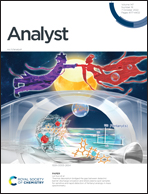Raman imaging combined with an improved PCA/algebra-based algorithm to capture microplastics and nanoplastics
Abstract
Raman imaging has advanced recently to be able to directly visualise microplastics and even nanoplastics. However, the generated scanning spectrum matrix, akin to a hyperspectral matrix, is challenging to decode. To this end, herein, logic-based, algebra-based, principal component analysis (PCA)-based, and dual-PCA-based algorithms are compared and combined as a PCA/algebra-based algorithm. Specifically, (i) to increase the signal–noise ratio, multiple images that mapped the multiple characteristic peaks of plastics are merged to cross-check each other. The threshold-based logic algorithm is improved by differentiating the intrinsic peak intensity, using an algebra-based algorithm; (ii) PCA can decode the spectrum matrix to generate PCA spectra and PCA images. The PCA spectra can suggest how to further extract information on plastics to merge the corresponding PCA images to enable the capture of microplastics and nanoplastics, by combining and following up with the algebra-based algorithm, called a PCA/algebra-based algorithm; (iii) dual-PCA analysis is employed to guide and extract the multiple PCA spectra towards image merging, to validate the PCA/algebra-based algorithm. We also show that the score percentages of the eigenvalues of PCA can be used to estimate the size amount of the microplastics and nanoplastics in the scanning area, and how to treat the reversed peaks of the PCA spectrum. Overall, the improvement of the algorithms can lead to more effective decoding of the spectrum matrix.



 Please wait while we load your content...
Please wait while we load your content...